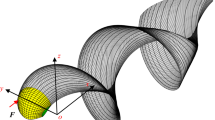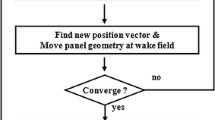Abstract
This paper analyzed the hydroelastic behaviors of hydrofoils and marine propellers immersed in incompressible, inviscid and irrotational fluids. Strongly coupled fluid–structure interaction analyses were performed using a three-dimensional (3-D) potential-based panel method in conjunction with a 3-D finite element method. The present method is developed for hydroelastic analyses of geometrically complex-shaped propeller blades, and the application of the method to the hydroelastic problems of hydrofoils is straightforward. The parameters dominating the added-mass and -damping matrices of the hydrofoils and propellers are examined. The effects of the translational motion of the hydrofoil and the rotational motion of the propeller on the added-mass and -damping matrices are compared based on different non-penetration boundary conditions and distributions of the inflow velocity. It is found that for hydroelastic analyses of propellers, the reduced frequency, i.e., the ratio of excitation frequency to rotational frequency, is a key parameter for determining the added-mass and -damping matrices of the propellers. The effect of the advance ratio on the added-mass and -damping matrices of the propeller blade depends upon the ratio of excitation frequency to rotational frequency. For hydrofoils, the added-damping matrix is significantly affected by the ratio of the excitation frequency multiplied by chord length and divided by axial inflow velocity.










Similar content being viewed by others
References
Seeley CE, Coutu A, Monette C, Nennemann B, Marmont H (2013) Determination of hydrofoil damping due to fluid structure interaction using MFC actuators. In: 54th AIAA/ASME/ASCE/AHS/ASC Struct Struct Dyn Mater Conf, Boston, Massachusetts, pp 1–12. https://doi.org/10.2514/6.2013-1910
Monette C, Nennemann B, Seeley C, Coutu A, Marmont H (2014) Hydro-dynamic damping theory in flowing water. In: 27th IAHR Symp Hydraul Mach Syst Montréal, QC, Canada. https://doi.org/10.1088/1755-1315/22/3/032044
La Torre OD, Escaler X, Egusquiza E, Farhat M (2013) Experimental investigation of added mass effects on a hydrofoil under cavitation conditions. J Fluids Struct 39:173–187. https://doi.org/10.1016/j.jfluidstructs.2013.01.008
Chae EJ, Akcabay DT, Lelong A, Astolfi JA, Young YL (2016) Numerical and experimental investigation of natural flow-induced vibrations of flexible hydrofoils. Phys Fluids 28:104–108. https://doi.org/10.1063/1.4954785
Lelong A, Guiffant P, Andr J (2016) An experimental analysis of the structural response of flexible lightweight hydrofoils in various flow conditions. In: Int Symp Transp Phenom Dyn Rotating Mach., Hawaii, Honolulu, pp 1–9
Liu X, Zhou L, Escaler X, Wang Z, Luo Y, La Torre OD (2017) Numerical simulation of added mass effects on a hydrofoil in cavitating flow using acoustic fluid–structure interaction. J Fluids Eng 139:1–8. https://doi.org/10.1115/1.4035113
Cao W, Xu H, Ren H, Wang C (2015) Numerical study on characteristics of 3D cavitating hydrofoil. In: Int. Conf. Energy Mater Manuf Eng, pp 4–10
Astolfi JA, Lelong A, Bot P, Marchand JB (2015) Experimental analysis of hydroelastic response of flexible hydrofoils. In: 5th High Perform. Yacht Des. Conf., Auckland, pp 10–12
Martio J, Sánchez-Caja A, Siikonen T (2015) Evaluation of propeller virtual mass and damping coefficients by URANS-method. In: Int Symp Mar Propulsors
Hutchison S, Steen S, Sanghani A (2013) Numerical investigation of ducted propeller added mass. In: Third Int. Symp. Mar. Propulsors, Launceston, Tasmania, Australia, pp 69–77
Gaschler M, Abdel-Maksoud M (2014) Computation of hydrodynamic mass and damping coefficients for a cavitating marine propeller flow using a panel method. J Fluids Struct 49:574–593. https://doi.org/10.1016/j.jfluidstructs.2014.06.001
Mao Y, Young YL (2016) Influence of skew on the added mass and damping characteristics of marine propellers. Ocean Eng 121:437–452. https://doi.org/10.1016/j.oceaneng.2016.05.046
MacPherson DM, Puleo VR, Packard MB (2007) Estimation of entrained water added mass properties for vibration analysis. Soc Nav Archit Mar Eng. pp 1–11
Martio J, Sánchez-Caja A, Siikonen T (2017) Open and ducted propeller virtual mass and damping coefficients by URANS-method in straight and oblique flow. Ocean Eng 130:92–102. https://doi.org/10.1016/j.oceaneng.2016.11.068
Van Esch BPM, Van Hooijdonk JJA, Bulten NWH (2013) Quantification of hydrodynamic forces due to torsional and axial vibrations in ship propellers. In: Proc ASME 2013 Fluids Eng Div Summer Meet, Incline Village, Nevada, USA
Yari E, Ghassemi H (2016) Boundary element method applied to added mass coefficient calculation of the skewed marine propellers. Polish Marit Res 23:25–31. https://doi.org/10.1515/pomr-2016-0017
Young YL (2007) Time-dependent hydroelastic analysis of cavitating propulsors. J Fluids Struct 23:269–295. https://doi.org/10.1016/j.jfluidstructs.2006.09.003
Young YL (2008) Fluid–structure interaction analysis of flexible composite marine propellers. J Fluids Struct 24:799–818. https://doi.org/10.1016/j.jfluidstructs.2007.12.010
Kuo J, Vorus W (1985) Propeller blade dynamic stress. In: Tenth Sh. Technol Res Symp, Norfolk, pp 39–69
Tsushima H, Sevik M (1973) Dynamic response of marine propellers to nonuniform flowfields. J Hydronaut 7:71–77
Lee H, Song M, Suh J, Chang B (2014) Hydro-elastic analysis of marine propellers based on a BEM-FEM coupled FSI algorithm. Int J Nav Archit Ocean Eng 6:562–577. https://doi.org/10.2478/IJNAOE-2013-0198
Maljaars PJ, Kaminski ML (2015) Hydro-elastic analysis of flexible propellers: an overview. In: Fourth Int. Symp. Mar. Propulsors, Austin, Texas, USA
Neugebauer J, Abdel-Maksoud M, Braun M (2008) Fluid–structure interaction of propellers. IUTAM Symp Fluid Struct Interact Ocean Eng 8:191–204
Lin HJ, Tsai JF (2008) Analysis of underwater free vibrations of a composite propeller blade. J Reinf Plast Compos 27:447–458. https://doi.org/10.1177/0731684407082539
He XD, Hong Y, Wang RG (2012) Hydroelastic optimisation of a composite marine propeller in a non-uniform wake. Ocean Eng 39:14–23. https://doi.org/10.1016/j.oceaneng.2011.10.007
Suo Z, Guo R (1996) Hydroelasticity of rotating bodies—theory and application. Mar Struct 9:631–646. https://doi.org/10.1016/0951-8339(95)00010-0
Li J, Qu Y, Hua H (2017) Hydroelastic analysis of underwater rotating elastic marine propellers by using a coupled BEM-FEM algorithm. Ocean Eng 146:178–191. https://doi.org/10.1016/j.oceaneng.2017.09.028
Li J, Rao Z, Su J, Qu Y, Hua H (2018) A numerical method for predicting the hydroelastic response of marine propellers. Appl Ocean Res 74:188–204. https://doi.org/10.1016/j.apor.2018.02.012
Qu F, Chen J, Sun D, Bai J, Yan C (2019) A new all-speed flux scheme for the Euler equations. Comput Math Appl 77(4):1216–1231. https://doi.org/10.1016/j.camwa.2018.11.004
Morino L, Kuo C-C (1974) Subsonic potential aerodynamic for complex configurations: a general theory. AIAA J 12:191–197
Theodorsen T (1935) General theory of aerodynamic instability and the mechanism of flutter. NACA Tech Rep 496
Kerwin JE, Lee C-S (1978) Prediction of steady and unsteady marine propeller performance by numerical lifting-surface theory. SNAME Trans 86:218–253
Greeley DS, Kerwin JE (1982) Numerical methods for propeller design and analysis in steady flow. SNAME Trans 90:415–453
Liefvendahl M, Troëng C (2011) Computation of cycle-to-cycle variation in blade load for a submarine propeller, using LES. In: Second Int Symp Mar Propulsors, Hamburg, Germany
Acknowledgements
This work was supported by National Natural Science Foundation of China (Grant Nos. 51839005, 11602138, 51579109 and 51479079).
Author information
Authors and Affiliations
Corresponding authors
Additional information
Publisher's Note
Springer Nature remains neutral with regard to jurisdictional claims in published maps and institutional affiliations.
About this article
Cite this article
Li, J., Qu, Y., Zhang, Z. et al. Parametric analysis on hydroelastic behaviors of hydrofoils and propellers using a strongly coupled finite element/panel method. J Mar Sci Technol 25, 148–161 (2020). https://doi.org/10.1007/s00773-019-00638-z
Received:
Accepted:
Published:
Issue Date:
DOI: https://doi.org/10.1007/s00773-019-00638-z




